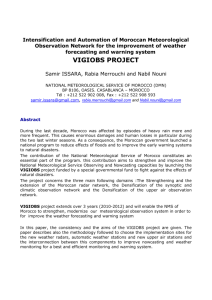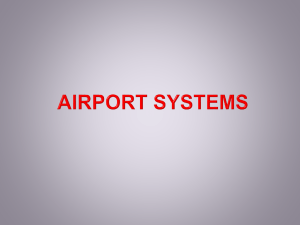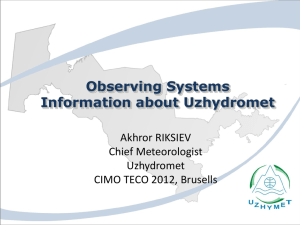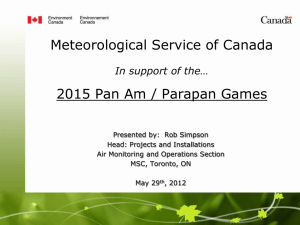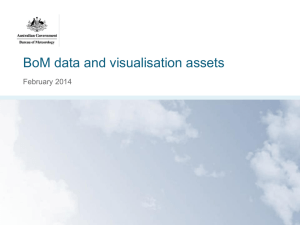1(06)_nouni
advertisement
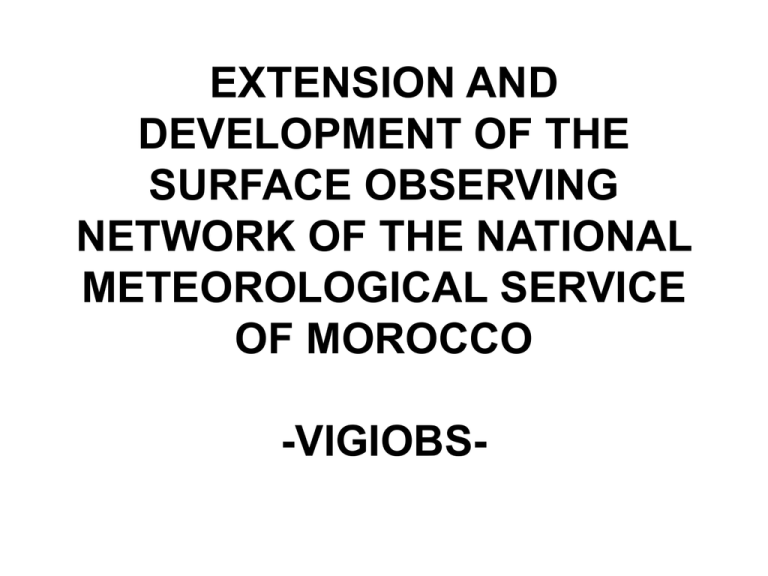
EXTENSION AND DEVELOPMENT OF THE SURFACE OBSERVING NETWORK OF THE NATIONAL METEOROLOGICAL SERVICE OF MOROCCO -VIGIOBS- Introduction During the last decade, Morocco was affected by episodes of heavy rain more and more frequent. This causes enormous damages and human losses in particular during the two last winter seasons. As a consequence, the Moroccan government launched a national program to reduce effects of floods and to improve the early warning systems to natural disasters. Introduction The contribution of the National Meteorological Service of Morocco constitutes an essential part of the program. This contribution aims to strengthen and improve the National Meteorological Service Observing and Nowcasting capacities by launching the VIGIOBS. Project funded by a special governmental fund to fight against the effects of natural disasters. The project concerns the three main following domains :the Strengthening and the extension of the Moroccan radar network, the Densification of the synoptic and climatic observation network and the Densification of the upper air observation network. VIGIOBS VIGIOBS project extends over 3 years (20102012) and will enable the NMS of Morocco to strengthen, modernize our meteorological observation system in order to improve the weather forecasting and warning system Project Objectives The main objectives of the VIGIOBS project are : • Improved weather watch through the strengthening of the real-time observation • Improving the quality of weather forecasts • Increase the density of the observational network and its automation • Cover all provinces of the Kingdom by WOS • Strengthening the weather in mountainous zones, Consistencies of the project The VIGIOBS project will enable National Weather strengthen modernize and improve its weather observation system by installing: 3 Doppler Weather Radar to cover East Region, South-East and South regions 60 synoptic automatic weather stations; 90 auxiliary automatic weather stations; 06 automatic weather stations in mountain areas; 03 Upper air stations (new rawinsonde systems). Project Planning The project will be implemented in three phases over the period 2010-2012. For each phase there will be the installation of: 01 Doppler Weather Radar 20 synoptic automatic weather stations; 30 auxiliary automatic weather stations 02 automatic weather stations in mountain areas; 01 Upper air stations (new rawinsonde systems). New Weather Radar Network of Morocco Several factors were considered in order to prioritize the siting of new radars for optimizing the current network and expanding the coverage of the weather radar network of Morocco. In terms of overall radar coverage for the entire country the region from the northwest Atlantic coast south to about the city of Agadir is relatively well covered, while the region east of the Atlas Mountains from the Mediterranean south through the Southern Provinces of Morocco is nearly devoid of radar coverage. Many factors can be used to assess new coverage areas, but the more important factors being considered for new radar placements are as follows, in order of importance: New Weather Radar Network of Morocco 1. 2. 3. 4. 5. Areas currently without radar coverage where the addition of a radar would improve public safety in the event of a weather related disaster; e.g., estimation of precipitation over key drainage basins where flooding has been common and resulted in loss of life. Areas without coverage where a new radar would improve short-term forecasts and warnings that could result in a decrease in economic loss to urban areas, industry, and agriculture; e.g., as in 1, but where damage is more related to infrastructure or crops rather than people. Areas without coverage where radar could generally improve the forecasts issued by the Department of Meteorology (DMN); generally filling in the gaps found in the current coverage, or extending coverage to offshore areas. The addition of radar to improve warnings related to aviation safety (strong winds, wind shear, heavy precipitation, etc.). The addition of radar to aid specific projects such as hail suppression programs and snow enhancement programs (e.g., hail algorithms to detect hail-bearing storms). DEBDOU ERFOUD TAN TAN DAKHLA Mosaic of proposed radar network, including existing and proposed radar Sites Automated meteorological station network of morocco Currently the Moroccan meteorological station network is not very dense and is partially automated. The weather observation in Morocco depends largely on the human presence. That implies necessarily the absence of meteorological data on large regions of Morocco and in case they are present their concentration and their treatment remains difficult. Morrocan network before VIGIOBS The Moroccan automatic weather station network presented several problems: •Low density of the network and bad distribution •Variety of data storage format •Lack of automatic transmission solution •No automatic coding meteorological message •Data transmission require in most cases human intervention and the passage through other local treatment system •Data transmission is done by technical means become obsolete and expensive: the analogue leased lines. VIGIOBS The project comes to address these issues for a better distribution of the Moroccan observation network, a high availability of data for their easy storage and treatment at end of climate studying and weather forecasting. Tange r With VIGIOBS Project Morocco Synoptic Observation Network 256 Automatic Weather Station Oujda Rabat Casablanca El Jadida Bouaarfa Errachidi a Agadir Ouarzaza te Tarfaya Essmara Eddakhla Lagouira VIGIOBS Observation Network automatic weather stations network For each site the proposed system consists of the following : datalogger, Sensors local system for concentration, processing, display and dissemination radio modem for communication between the datalogger and thelocal system of concentration. GSM modem for communication between the datalogger and acentral concentration .system automatic weather stations network At central level (Casablanca): Two central servers (in normal and backup configuration) for concentration, processing, visualization and dissemination automatic weather stations network The local data concentration system allow : acquisition , controle, arhiving, coding, visualization dissemination of meteorological data. automatic weather stations network Both concentrations, processing and visualization servers of data from automatic weather stations use the UDCS and CLDB as software. Those two software are opened and accept different data format from several types of automatic stations. The number of stations that can be concentrated by those servers is limited only by the communication infrastructure. The central servers allow, through a Web interface, a near real-time access and display of all measured and developed parameters and state parameters of automatic stations. automatic weather stations network UDCS : is a data collection and switching system. It provides users with web interface : acess to all data, statistics and full functionality from any computer on the moroccan meteorological LAN/WAN. It allow data validation It allow network monitoring automatic weather stations network CLDB : Is an unified structure based on SQL Database Server and the standard data access is based on SQL language is used. automatic weather stations network CLDB : Climatological data in the CLDB system are processed through different modules before storing in database. They are collected from different sources by the data collection & decoding module. The decoding module decodes received data and passes them to the quality control module. automatic weather stations network CLDB : Detailed observing stations description and history metadata is inevitable part of climate data itself. Metadata are organized in three groups: Station Geography Observation Description 3. Station Extremes automatic weather stations network The transmission of data to the Local concentration system : Transmitted data The parameters measured by sensors, concentrated and processed by the datalogger and the state of all elements of the automatic station Transmission media Connections between the datalogger and, local concentration system will be performed by wireless devices : Radio. automatic weather stations network The transmission of data to the central concentration system (headquarters of the DMN in Casablanca): Transmitted data It is possible to schedule the transmission of raw data (from the datalogger and the local system of concentration), coded messages (SYNOP, METAR,… ) and state data from the local concentration system to the central concentration system. The administrator of the automatic station has the ability to configure a selected data transmission. Transmission media The automatic station send data to central level by two media : VPN IP by the Ethernet interface of the local system of concentration GSM modem directly from the datalogger. automatic weather stations network The local and the central systems of concentration can send meteorological messages by FTP to the Moroccan AMSS (TRANSMET) who is connected to the GTS. automatic weather stations network IMPLEMENTATION In accordance with international standards automatic stations are installed in parks. For good representativeness of Measured Data realization of these parks is consistent with the standards prescribed in WMO references (including Chapter 1 of WMO No. 8) especially as regards the dimensions of the park's protection, provision and sensors exposition ... We chose to install the Automatics weather stations in the sites of our partners and sites belonging to other State Department.... Thank you for your attention
